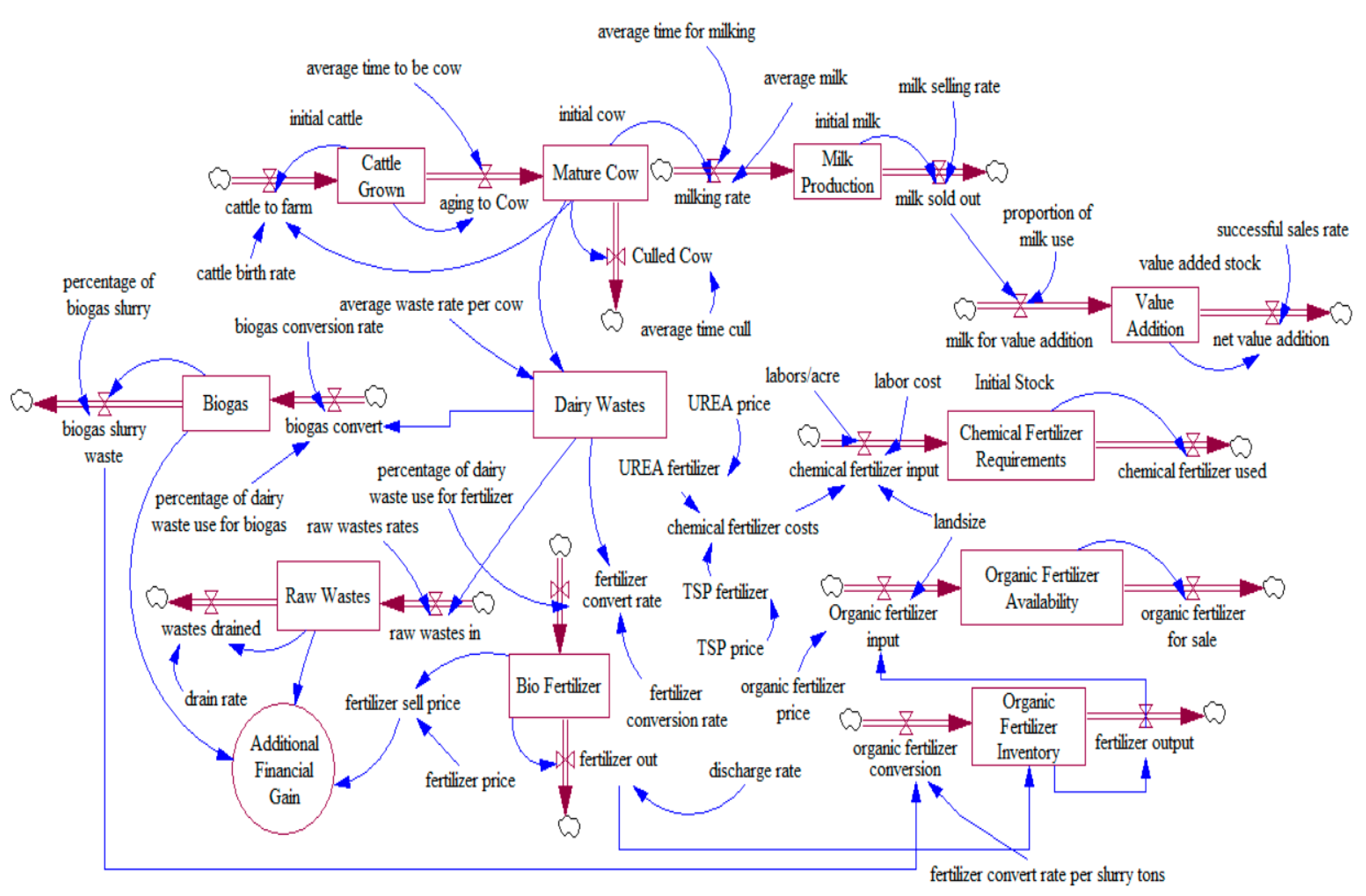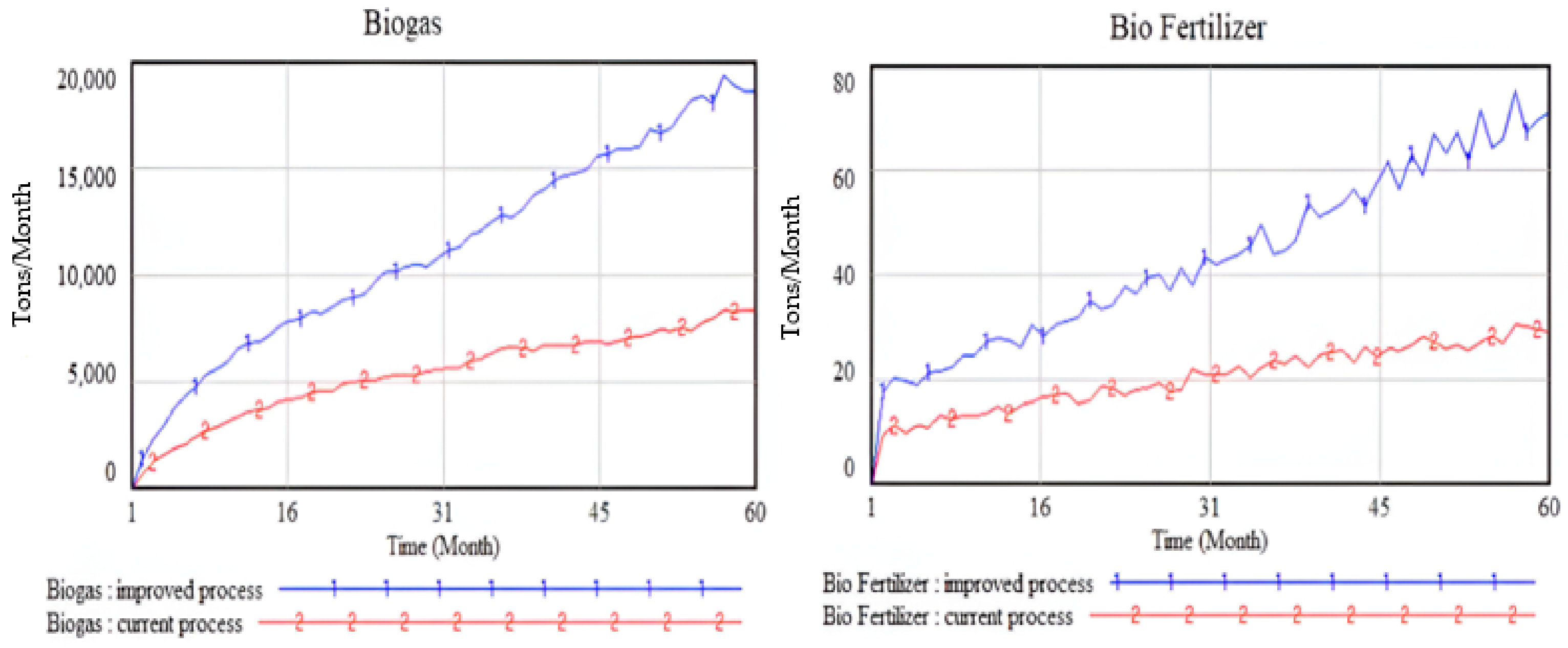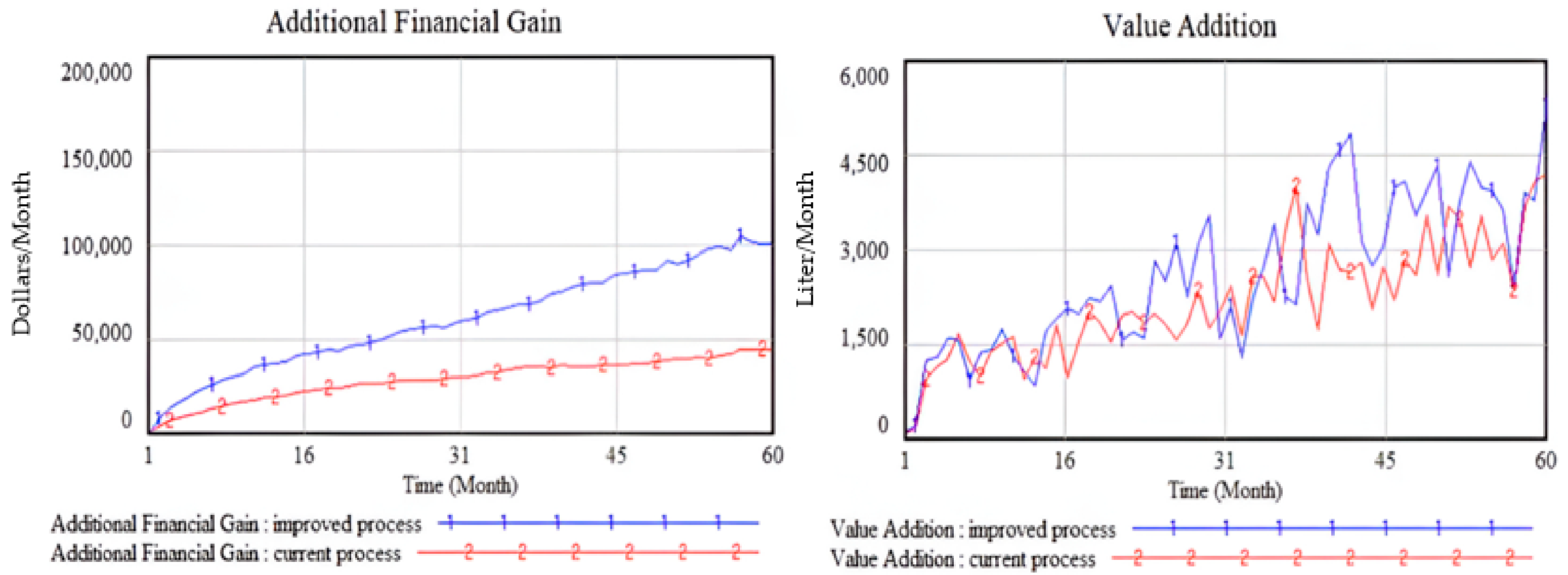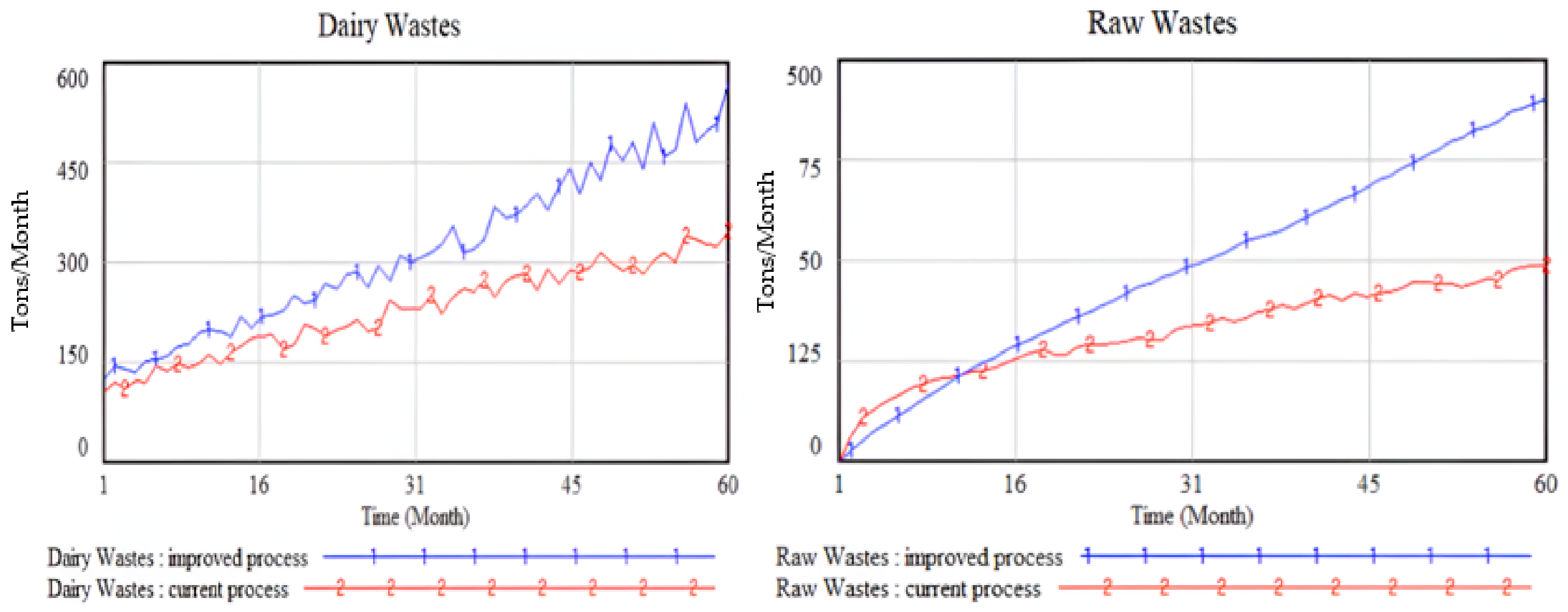Utilizing Dairy Waste Processing for Organic Agricultural Production: A Sustainable Approach to Producing Organic Goods
Abstract
1. Introduction
Objectives
- Evaluate the current processing and transformation techniques used to convert dairy waste into biofertilizers and biogas to meet agricultural demands while improving organic ingredients.
- Assess the consequences of fertilizers derived from dairy manure on soil fertility, the yield of crops, and the quality of the products of organic farming.
- Evaluate the sustainability of and stakeholder perspectives on including dairy waste processing in organic farming techniques.
2. Literature Review
2.1. Organic Farming and Sustainability
2.2. Bangladesh and Its Dairy Operations
2.2.1. Production Systems
2.2.2. Cattle Breed
2.2.3. Feed Habits
2.2.4. Manage Cattle Health
2.2.5. Reproduction Management
2.2.6. Market Mechanism
2.3. Challenges
2.4. Factors and Trends Driving Organic Demand
Rising Sustainability Concerns
3. Materials and Methods
4. Results
- Table 2 categorizes different forms of dairy waste, encompassing dairy manure, dairy by-products (including whey and skim milk), and dairy slurry.
- The table delineates the potential repurposing of various dairy waste types for organic agricultural practices. Dairy waste serves as a natural fertilizer for crops and also aids in improving soil, which helps the soil to produce more crops in the following cycle. Moreover, the dairy slurry is appropriate for drainage and soil enrichment.
- The third column shows crops and vegetables that benefit from the use of dairy waste. Depending on how the dairy waste is used, this includes vegetables, fruits, legumes, field crops, forages, and grasslands.
- The table illustrates possible cost reductions that could result from using fertilizer made from dairy waste in the agricultural field. The reuse of dairy fertilizers, soil conditioners, or water sources minimizes farmers’ consumption of synthetic inputs and deep well water, chemical fertilizer, and additive costs.
- The table demonstrates how dairy waste benefits organic farming in light of achieving sustainability for the farm. This includes better resource utilization, reduced waste, enhanced soil fertility, higher crop yields, lower chemical inputs, improved water retention, and reduced greenhouse gas emissions. Integrating farm waste into organic agricultural processes enables farmers to achieve sustainable and environmental stewardship.
Dairy Process Model






5. Discussions
5.1. Theoretical and Practical Contributions
5.2. Theoretical Contributions:
- Advance in Agroecological Theory: Demonstrates the synergies between livestock and crop systems by applying ecological principles to optimize resource use, improve soil health, and foster biodiversity.
- Development of Sustainable Agriculture Frameworks: The improved process aligns with sustainability frameworks through holistic management, regenerative practices, and ecosystem-based solutions.
- Integration of Livestock and Crop Interactions: Enhances theoretical models by focusing on nutrient cycling, soil fertility management, and ecological balance.
5.3. Practical Contributions
- Improved Agricultural Sustainability: Optimizes resource use, minimizes environmental impacts, and enhances economic viability, promoting long-term farm resilience.
- Enhanced Soil Fertility and Productivity: Dairy waste is used as a fertilizer and soil conditioner to improve soil structure, water retention, and crop yields, reducing dependence on synthetic inputs.
- Minimized Environmental Impact: Reduces chemical inputs, lowers greenhouse gas emissions, and promotes biodiversity conservation.
- Market Opportunities and Economic Advantages: Higher market prices for organic dairy products boost profitability, diversify revenue streams, and enhance farmers’ economic resilience.
6. Conclusions
7. Study Limitations and Future Research Prospects
Author Contributions
Funding
Data Availability Statement
Acknowledgments
Conflicts of Interest
References
- Salter, A.M. Improving the sustainability of global meat and milk production. Proc. Nutr. Soc. 2017, 76, 22–27. [Google Scholar] [CrossRef] [PubMed]
- Bhunia, S.; Bhowmik, A.; Mallick, R.; Mukherjee, J. Agronomic Efficiency of Animal-Derived Organic Fertilizers and Their Effects on Biology and Fertility of Soil: A Review. Agronomy 2021, 11, 823. [Google Scholar] [CrossRef]
- Shete, B.S.; Shinkar, N. Dairy Industry Wastewater Sources, Characteristics & Its Effects on Environment. Int. J. Curr. Eng. Technol. 2013, 3, 1611–1615. [Google Scholar]
- Shamsuddoha, M.; Koul, S.; Taylor, I.W. Eco-efficient Dairy Waste Treatment: Validating a Sustainable System Dynamics Framework. SN Oper. Res. Forum 2024, 5, 1–27. [Google Scholar] [CrossRef]
- Shamsuddoha, M.; Woodside, A.G. Sustainability Process Innovations Resulting in New Value-Added By-Products: Principal Lessons from Second-Order System-Dynamics Engineering (SOSDE). J. Bus. Ind. Mark. 2023, 38, 2403–2416. [Google Scholar] [CrossRef]
- Adegbeye, M.J.; Salem, A.Z.M.; Reddy, P.R.K.; Elghandour, M.M.M.; Oyebamiji, K.J. Waste Recycling for the Eco-Friendly Input Use Efficiency in Agriculture and Livestock Feeding. In Resources Use Efficiency in Agriculture; Springer: Singapore, 2020; pp. 1–45. [Google Scholar]
- Singha, R.; Singha, S. Composting for a Sustainable Future: Turning Waste into Nutrient-Rich Soil. In Water-Soil-Plant-Animal Nexus in the Era of Climate Change; IGI Global: Hershey, PA, USA, 2024; pp. 279–297. [Google Scholar]
- Shamsuddoha, M.; Nasir, T.; Ibne Hossain, N.U. Integrating Circular Economy and Reverse Logistics for Achieving Sustainable Dairy Operations. In Data Analytics for Supply Chain Networks; Springer: Cham, Switzerland, 2023; pp. 211–226. [Google Scholar]
- Ahmad, T.; Aadil, R.M.; Ahmed, H.; ur Rahman, U.; Soares, B.C.; Souza, S.L.; Pimentel, T.C.; Scudino, H.; Guimarães, J.T.; Esmerino, E.A.; et al. Treatment and Utilization of Dairy Industrial Waste: A Review. Trends Food Sci. Technol. 2019, 88, 361–372. [Google Scholar] [CrossRef]
- Lin, L.; Xu, F.; Ge, X.; Li, Y. Biological Treatment of Organic Materials for Energy and Nutrients Production—Anaerobic Digestion and Composting. In Advances in Bioenergy; Elsevier: Amsterdam, The Netherlands, 2019; Volume 4, pp. 121–181. [Google Scholar]
- Zarin, I.; Talukder, A.K.; Hoque, M.N.; Rahman, M.; Haider, G.; Rahman, A.N.M.A.; Das, Z.C. Current scenario on reproductive management and performances of dairy cows in Manikganj district. Ann. Bangladesh Agric. 2023, 27, 129–144. [Google Scholar] [CrossRef]
- Hiranmai, R.Y.; Neeraj, A.; Vats, P. Improvement of Soil Health and Crop Production through Utilization of Organic Wastes: A Sustainable Approach. Int. J. Recycl. Org. Waste Agric. 2024, 13, 1–15. [Google Scholar]
- Shah, F.; Wu, W. Soil and Crop Management Strategies to Ensure Higher Crop Productivity within Sustainable Environments. Sustainability 2019, 11, 1485. [Google Scholar] [CrossRef]
- Sheer, A.; Sardar, M.F.; Younas, F.; Zhu, P.; Noreen, S.; Mehmood, T.; Farooqi, Z.U.R.; Fatima, S.; Guo, W. Trends and Social Aspects in the Management and Conversion of Agricultural Residues into Valuable Resources: A Comprehensive Approach to Counter Environmental Degradation, Food Security, and Climate Change. Bioresour. Technol. 2023, 394, 130258. [Google Scholar] [CrossRef]
- Singaravadivelan, A.; Sachin, P.B.; Harikumar, S.; Vijayakumar, P.; Vindhya, M.V.; Farhana, F.M.B.; Rameesa, K.K.; Mathew, J. Life cycle assessment of greenhouse gas emission from the dairy production system—Review. Trop. Anim. Health Prod. 2023, 55, 320. [Google Scholar] [CrossRef] [PubMed]
- Rashid, M.H.; Bokhtiar, S.M.; Khan, M.A.S.; Ali, M.S. Bangladesh Livestock Research Priorities; Bangladesh Agricultural Research Council: Dhaka, Bangladesh, 2023; pp. 978–984. [Google Scholar]
- Saadullah, M. Smallholder Dairy Production and Marketing in Bangladesh. In Smallholder Dairy Production and Marketing—Opportunities and Constraints; Bangladesh Agricultural Research Council: Dhaka, Bangladesh, 2002; pp. 7–21. [Google Scholar]
- Hassan, M.R.; Sultana, S.; Pehan, E.A.; Sultana, S.; Sadat, A.; Afsana, A.S.; Islam, M.A.; Sultana, N. Dairy Production and Livelihood Scenario in Different Climatic Regions of Bangladesh. Singap. J. Sci. Res. 2023, 13, 109–123. [Google Scholar] [CrossRef]
- Animals Australia. What Happens to Dairy Calves? 2021. Available online: https://animalsaustralia.org/our-work/farmed-animals/what-happens-to-dairy-calves/ (accessed on 18 September 2024).
- Saha, S.; Hasan, M.N.; Uddin, M.N.; Rahman, B.M.; Khan, M.M.H.; Ahmed, S.S.U.; Kitazawa, H. A Comparison between Cross-Bred (Holstein × Local Cattle) and Bangladeshi Local Cattle for Body and Milk Quality Traits. Dairy 2024, 5, 153–160. [Google Scholar] [CrossRef]
- Galukande, E.; Mulindwa, H.; Wurzinger, M.; Roschinsky, R.; Mwai, A.O.; Sölkner, J. Cross-Breeding Cattle for Milk Production in the Tropics: Achievements, Challenges and Opportunities. Anim. Genet. Resour. 2013, 52, 111–125. [Google Scholar] [CrossRef]
- Getu, A.; Biru, G.; Arbse, D. Cross Breeding Effect on the Performance of Indigenous Cattle: Challenges and Opportunities. J. Agric. Sci. Food Technol. 2015, 1, 16–21. [Google Scholar]
- Islam, M.A.; Sharma, A.; Ahsan, S.; Mazumdar, S.; Rudra, K.; Phillips, C.J. Welfare Assessment of Dairy Cows in Small Farms in Bangladesh. Animals 2020, 10, 394. [Google Scholar] [CrossRef]
- Roess, A.A.; Winch, P.J.; Ali, N.A.; Akhter, A.; Afroz, D.; El Arifeen, S.; Darmstadt, G.L.; Baqui, A.H. Animal Husbandry Practices in Rural Bangladesh: Potential Risk Factors for Antimicrobial Drug Resistance and Emerging Diseases. Am. J. Trop. Med. Hyg. 2013, 89, 965–970. [Google Scholar] [CrossRef] [PubMed]
- Grasseni, C. Managing Cows: An Ethnography of Breeding Practices and Uses of Reproductive Technology in Contemporary Dairy Farming in Lombardy (Italy). Stud. Hist. Philos. Sci. Part C Stud. Hist. Philos. Biol. Biomed. Sci. 2007, 38, 488–510. [Google Scholar] [CrossRef]
- Muzareba, A.M.; Khondkar, M. Insights on Production End of the Dairy Value Chain in Bangladesh. Am. J. Qual. Res. 2021, 5, 142–162. [Google Scholar] [CrossRef]
- Kabir, M.R.; Islam, S. Behavioural intention to purchase organic food: Bangladeshi consumers’ perspective. Br. Food J. 2021, 124, 754–774. [Google Scholar] [CrossRef]
- Popa, M.E.; Mitelut, A.C.; Popa, E.E.; Stan, A.; Popa, V.I. Organic foods contribution to nutritional quality and value. Trends Food Sci. Technol. 2019, 84, 15–18. [Google Scholar] [CrossRef]
- Zoll, F.; Specht, K.; Opitz, I.; Siebert, R.; Piorr, A.; Zasada, I. Individual choice or collective action? Exploring consumer motives for participating in alternative food networks. Int. J. Consum. Stud. 2018, 42, 101–110. [Google Scholar] [CrossRef]
- Forrester, J.W. The Beginning of System Dynamics. McKinsey Quarterly, 1 November 1995; pp. 4–17. [Google Scholar]
- Shamsuddoha, M.; Nasir, T.; Hossain, N.U.I. A Sustainable Supply Chain Framework for Dairy Farming Operations: A System Dynamics Approach. Sustainability 2023, 15, 8417. [Google Scholar] [CrossRef]
| Particular | Dairy Farming Process | Relationship to Organic Agriculture |
|---|---|---|
| Nutrient Cycling | Manure provides organic nutrients for crops. | Manure enriches soil fertility, promoting sustainable crop growth and reducing reliance on synthetic fertilizers. |
| Soil Health Improvement | Organic matter enhances soil structure and moisture retention. | Improves soil water-holding capacity and microbial activity, leading to healthier crops and better yields. |
| Integrated Pest Management (IPM) | Uses biological controls to manage pests. | Dairy farms reduce pest control, supporting organic IPM strategies to decrease pesticide use. |
| Sustainable Resource Utilization | Recycles nutrients efficiently through manure application. | Lowers environmental footprint by reducing synthetic inputs and promotes eco-friendly agriculture. |
| Biodiversity Conservation | Provides diverse fodder and adopts agroforestry. | Increases biodiversity, creating resilient ecosystems that benefit organic crop production. |
| Animal Welfare | Prioritizes animal access to pasture and humane treatment. | Improves animal health, ensuring higher quality organic animal products through grazing lands and corn stover or paddy straw. |
| Regenerative Agriculture | Uses manure for soil fertility and carbon sequestration. | Supports organic practices in enhancing ecosystem health and mitigating climate change. |
| Market Access | Organic practices offer access to premium dairy markets. | Increases profitability by accessing premium organic markets for crops and livestock. |
| Community Resilience | Supports local food systems and small farmers. | Strengthens local economies and ensures sustainable food systems through collaboration. |
| Additional Production Cycles | Aligns milk production with crop harvests for stability. | Synchronizes crop and livestock cycles, improving productivity and resource use efficiency. |
| Feed Source Integration | Uses crop residues like straw as fodder. | Reduces waste by recycling crop residues, lowering feed costs, and benefiting organic pest control. |
| Dairy Waste | Organic Practice | Benefit | Cost Savings | Organic Achievement |
|---|---|---|---|---|
| Cow dung | Organic fertilizer for crops | All crops, particularly vegetables, fruits, and grains | Reduced fertilizer purchase costs | Improved soil fertility and productivity, reduced chemical inputs |
| Dairy manure | Biogas | Biogas slurry to crops | Reduce energy costs | Reduce fossil fuel usage |
| Dairy by-products (e.g., skim milk) | Soil amendment and composting material | Vegetables, fruits, and legumes | Reduced soil amendment costs, potential revenue from by-product sales | Enhanced soil structure and fertility, increased microbial activity, reduced greenhouse gas emissions |
| Biogas slurry | Irrigation and soil conditioning | Field crops, forages, and grasslands | Reduced water and soil conditioner costs | Enhanced water retention, improved soil structure |
| Aspects | Details |
|---|---|
| Integration of Dairy Farming and Organic Agriculture | Improves sustainability, soil health, and product quality through nutrient recycling and resource efficiency by using dairy waste as fertilizers and irrigation. |
| Enhancing Soil Fertility and Health | Utilizes dairy manure to improve soil structure, water retention, and microbial activity, fostering crop development. |
| Reducing Chemical Inputs and Environmental Impacts | Eliminates synthetic chemicals, reduces soil, saves water consumption, decreases pollution greenhouse gas emissions, and improves ecosystems. |
| Improving Animal Welfare and Product | Quality emphasizes animal welfare with pasture access and ethical standards, producing high-quality, sustainable dairy products. |
| Market Opportunities and Consumer Demand | It meets growing consumer demand for organic products, offering farmers higher prices and diversification opportunities. |
Disclaimer/Publisher’s Note: The statements, opinions and data contained in all publications are solely those of the individual author(s) and contributor(s) and not of MDPI and/or the editor(s). MDPI and/or the editor(s) disclaim responsibility for any injury to people or property resulting from any ideas, methods, instructions or products referred to in the content. |
© 2024 by the authors. Licensee MDPI, Basel, Switzerland. This article is an open access article distributed under the terms and conditions of the Creative Commons Attribution (CC BY) license (https://creativecommons.org/licenses/by/4.0/).
Share and Cite
Shamsuddoha, M.; Nasir, T. Utilizing Dairy Waste Processing for Organic Agricultural Production: A Sustainable Approach to Producing Organic Goods. Processes 2024, 12, 2521. https://doi.org/10.3390/pr12112521
Shamsuddoha M, Nasir T. Utilizing Dairy Waste Processing for Organic Agricultural Production: A Sustainable Approach to Producing Organic Goods. Processes. 2024; 12(11):2521. https://doi.org/10.3390/pr12112521
Chicago/Turabian StyleShamsuddoha, Mohammad, and Tasnuba Nasir. 2024. "Utilizing Dairy Waste Processing for Organic Agricultural Production: A Sustainable Approach to Producing Organic Goods" Processes 12, no. 11: 2521. https://doi.org/10.3390/pr12112521
APA StyleShamsuddoha, M., & Nasir, T. (2024). Utilizing Dairy Waste Processing for Organic Agricultural Production: A Sustainable Approach to Producing Organic Goods. Processes, 12(11), 2521. https://doi.org/10.3390/pr12112521









